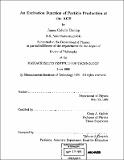An excitation function of particle production at the AGS
Author(s)
Dunlop, James Colville, 1972-
DownloadFull printable version (24.94Mb)
Other Contributors
Massachusetts Institute of Technology. Dept. of Physics.
Advisor
Craig A. Ogilvie.
Terms of use
Metadata
Show full item recordAbstract
Measurements of [pi]+ , K+ , K-, and p production from Au - Au reactions have been made by experiments E866 and E917 at the Brookhaven National Laboratory Alternating Gradient Synchrotron. The measurements have been made as a function of beam energy, at kinetic beam energies in the laboratory of 2 and 4 A· Ge V, by experiment E866, and of 6 and 8 A-GeV, by experiment E917. The data has been divided into event classes, based on the total multiplicity in an event. The particles were measured in an angular range from 14 to 57° . Within a range of rapidity Y - Ynn l < 0.25Ynn, and within the upper 339 mb in total multiplicity, the yields of all produced particles increase as the beam energy increases. The yields of Kincrease more rapidly with beam energy than those of the K+ , and those of the K+ increase more rapidly with beam energy than those of the [pi]+ . The (m.1 - mo) of the particles also increase as the beam energy increases, but not as rapidly as the yields. The ratio of the yields, K+ /[pi]+ , within this range of rapidity increases steadily from ... The K- / K+ ratio within this range of rapidity, in the upper 339 mb of total multiplicity, increases steadily from 8% at 4 A· GeVto 19% at 10.8 A· GeV. The K- / K+ ratio is constant as a function of centrality at all beam energies and rapidities measured. It is not constant with rapidity. The production of kaons therefore shows a clear consistency across all beam energies in the range measured in this thesis. Hadronic models cannot reproduce the dN /dY of K+ at all beam energies at this stage of their development. At an equal distance from the p - p production threshold, the K- yield is lower by a factor of 5 than than tl1e K+ yield. This stands in contrast to the value of 1.0±0.4 measured by the K aoS collaboration ...
Description
Thesis (Ph.D.)--Massachusetts Institute of Technology, Dept. of Physics, 1999. Includes bibliographical references (p. 412-417).
Date issued
1999Department
Massachusetts Institute of Technology. Department of PhysicsPublisher
Massachusetts Institute of Technology
Keywords
Physics.